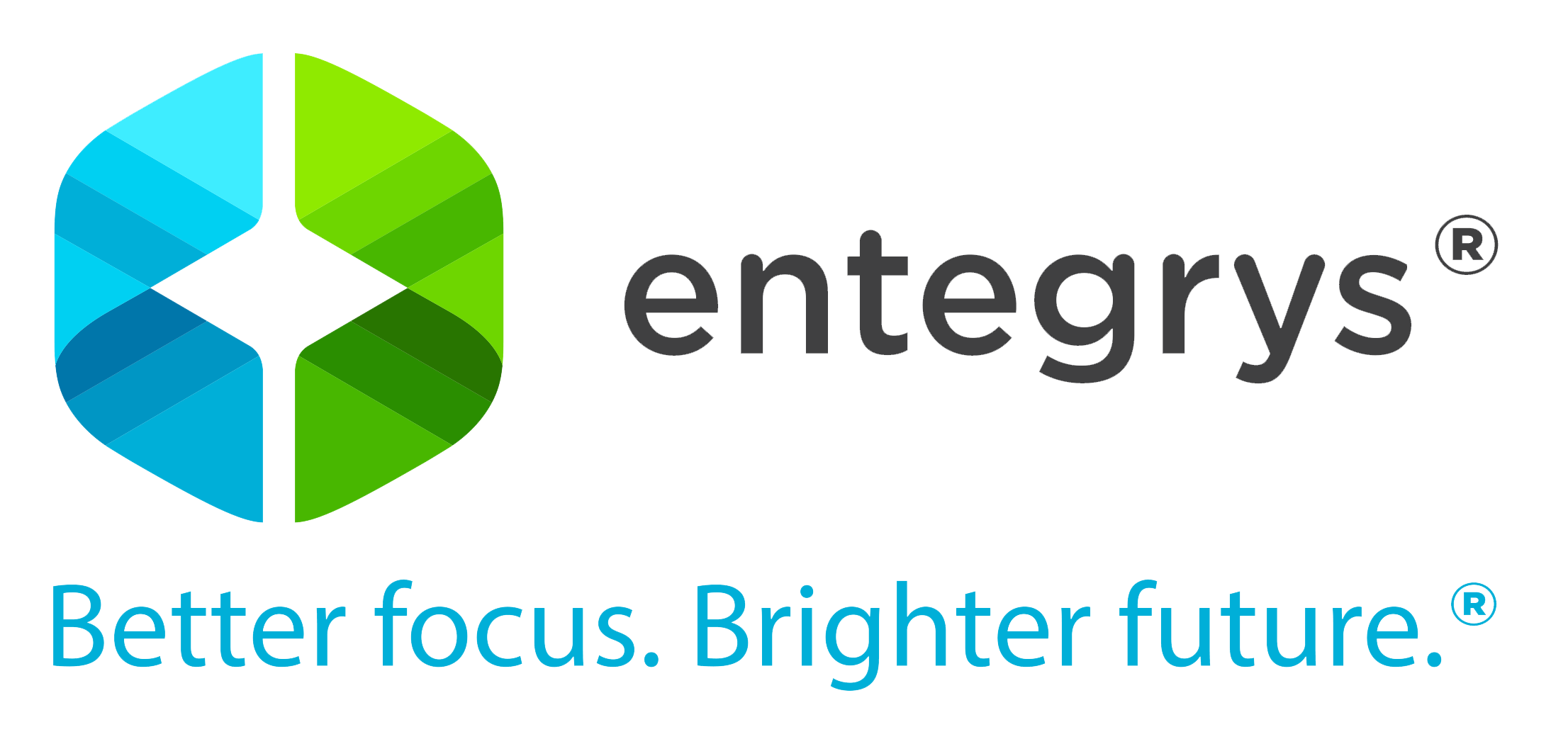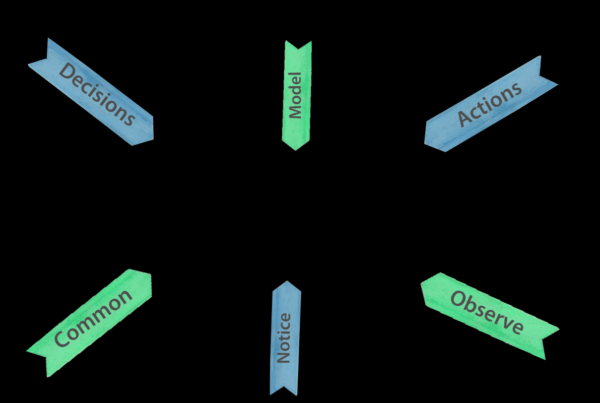Unexpected Wisdom from Alice in Wonderland
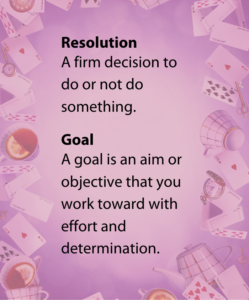
Here we are at the beginning of a New Year when our thoughts often turn to resolutions. But historically, we fail dismally with our New Year’s resolutions. The reasons why we fail may surprise you.
In short, resolutions are merely a starting point toward desired outcomes. Well-formed goals motivate us to take action and achieve our desired outcomes.
Join us to uncover wisdom from Alice in Wonderland about why resolutions fail, and how to transform them into goals we will work to achieve.
Transforming Resolutions to Goals
Pitfall # 1 We’re not actually resolved
After falling down the rabbit hole, Alice consumes some magical potions that cause her to grow and shrink inordinately. In confusion, she cries out, “Who in the world am I?”
This is not an easy question to answer, but until we can do, we will have difficulty being resolute.
Typical answers are I’m an analyst, a police officer, a carpenter, a prince, a father … Such answers only define our occupations, titles and roles—how others see and relate to us.
Literature offers many views on the definition of ‘true identity’. Most point to our self-perception—what we think, feel and believe about ourselves—and our inner passion. It develops over time from a fusion of our environment, experiences, memories, capabilities, values, and beliefs.
Goal Setting Principle #1 Find your passion
How is all this relevant to goal setting? Simply put, our passion drives our motivation. People who experience their work or life as drudgery will seldom be resolute enough to achieve peak performance.
So before you set your goals, take time to discover what ignites your passion. Some questions you might ask yourself are:
- How do I spend my free time?
- What brings me joy?
- What patterns do I see in what I buy and the books I read?
- What do I want people to say at my eulogy?
Tip: Discovering our passion is first and foremost a heart process. So quiet yourself and let the answers arise from within.
Pitfall #2 We haven’t articulated our outcome
The Cheshire Cat is commonly quoted as saying to Alice, “If you don’t know where you’re going, any road will get you there.”
Where do you want to go? What is your real goal?
Goal Setting Principle #2 Create a well-formed outcome
You’ve likely heard of SMART goals—specific, measurable, achievable, relevant and time-bounded. While there is value in these criteria, they also contain some hidden rabbit holes that can deflect us from achieving our goals.
The first is that we often state our goals in negative terms. For example, we may say our goal is to lose weight. Although that sounds positive, the words focus our subconscious mind on the obstacles to losing weight. But using our desired outcome as our goal statement—to become fit or look more attractive—motivates our subconscious toward that positive intention.
Tip: State your goal in words that clearly describe your desired outcome versus what you want to avoid, e.g. remember to … vs. don’t forget to ….
A second rabbit hole is that if we don’t know where we’re going, we won’t know when we get there.
Since our subconscious mind cannot differentiate between real and imagined, the more fully we can imagine it, the more we will believe we can achieve it. And belief in our goal fuels our motivation to achieve it.
A well-formed outcome describes our desired result in vivid sensory terms so we will recognize it when we achieve it. What does a successful outcome look like? Sound like? Taste like? Smell like? Feel like—physically and emotionally?
Tip: Describe your goal in vivid sensory terms.
And yet a third hole is that achievable and realistic goals seldom inspire us. Those who achieve great success have typically set ambitious goals for themselves.
The renowned mountaineer and author, W. H. Murray, wrote in The Scottish Himalayan Expedition:
“Concerning all acts of initiative (and creation), there is one elementary truth, the ignorance of which kills countless ideas and splendid plans: that the moment one definitely commits oneself, then Providence moves too.
All sorts of things occur to help one that would never otherwise have occurred. A whole stream of events issues from the decision, raising in one’s favour all manner of unforeseen incidents and meetings and material assistance, which no man could have dreamt would have come his way.”
Tip: Ensure your goal is big enough to motivate you and your team!
Pitfall #3 We plan to fail when we fail to plan
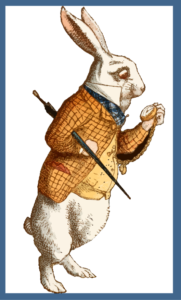 The White Rabbit rushed past Alice with his watch in his hand. She could hear him muttering frantically, “I’m late. I’m late. For a very important date I’m late. No time to say hello goodbye. I’m late. I’m late. I’m late.”
The White Rabbit rushed past Alice with his watch in his hand. She could hear him muttering frantically, “I’m late. I’m late. For a very important date I’m late. No time to say hello goodbye. I’m late. I’m late. I’m late.”
Frantic activity does not equal productivity.
Goal Setting Principle #3 Implement SMART Plans
The SMART formula proves its real value when planning for goal achievement. What are the steps we need to take to get there? How much time might each step take? What obstacles might we encounter? What contingency plans can we put in place if we fall down a rabbit hole?
Tip: Use the SMART formula to develop a concrete plan.
Pitfall #4 We fail to act
The king’s advise in Alice in Wonderland was “Begin at the beginning, the king said gravely, and go on till you come to the end: then stop.”
Goal Setting Principle #4 Take action!
Can it really be that simple?
As early as the 6th century BC, Lao Tzu wisely advised, “The journey of a thousand miles begins with a single step.”
Taking action is critical to achieving our goals. But it takes courage to take action. We can imagine all kinds of ‘what ifs’ and pitfalls that will derail our plans or outright stop us in our tracks.
If we fixate on the pitfalls, we’ll never take the first step or we’ll give up when challenges arise. In these times, we must return our focus to the desired outcome and let that vision reinforce our courage to continue on.
Don’t wait till your plan is perfect. Resources and solutions will come as you make the decision to start.
Tip: Take your first step soon and keep going until your reach your goal or prove it’s no longer attainable.
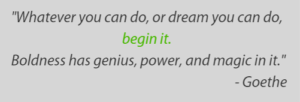
If one of your goals is to develop professionally, you can use our High Potential Profile to identify competencies to include in your plan.

Click here for three simple steps to get you started.
